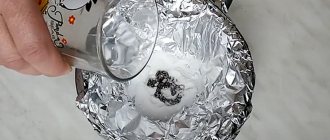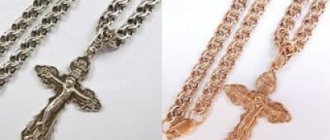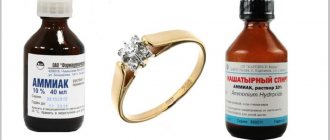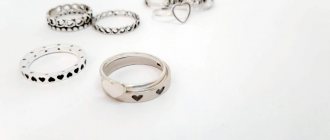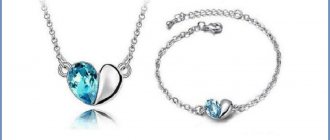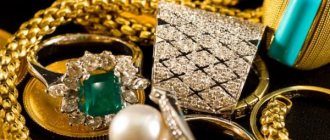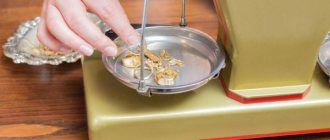Good day!
Silver is a beautiful precious metal, jewelry from which helps create a delicate and sophisticated look. They also love it because it looks appropriate at any age and with any skin type. However, silver also has disadvantages. For example, if metal is handled improperly, it turns black. Therefore, it is important for every owner of silver jewelry to know how to clean silver with and without stones. Here it is important to take into account the degree of contamination of the metal, the type of insert, and even the sample of the product.
Compatibility of silver with stones. What can cause silver to darken?
Despite the fact that silver is an inexpensive metal, it is distinguished by its ability to be combined with various stones. At the same time, the finished products look noble; based on external features, they can be classified as a higher price category. This combination has been used for many centuries and remains relevant today. The stones that are best combined with silver are noted (taking into account color, esoteric beliefs and centuries-old folk traditions):
- emerald;
- rauchtopaz;
- morion;
- diamond;
- sapphire;
- cubic zirconia;
- topaz;
- lapis lazuli;
- onyx;
- nephritis;
- agate.
Preparing tools for stripping. The nuances of effective cleansing
When planning to clean silver jewelry in your home, you first need to prepare. The choice of means depends on the method used. The tools are most often the same. You will need:
- toothpicks;
- container for mixing components and preparing a solution;
- cotton buds;
- Toothbrush;
- lint-free rags;
- polishing cloth.
Cleaning a silver ring with toothpaste
Rules that will help you quickly and effectively remove dirt from stones and additionally restore the shine of silver:
- It is prohibited to use abrasives: dry powders, hard brushes for cleaning stones on jewelry;
- do not use aggressive agents, this can lead to changes in the properties of organic and synthetic inserts - they will become cloudy;
- sometimes glue is used to attach stones, in this case it is not recommended to abuse water;
- if you need to process only metal using more aggressive solutions, you must first cover the jewelry inserts so as not to spoil them;
- Temperature changes should not be allowed during basic manipulations;
- After the procedure is completed, the products are polished using a special cloth.
Cleaning methods
To clean silver, you can use professional products or resort to traditional methods. In the second case, several recommendations that are common to all methods should be taken into account:
- Cleaning is carried out with a soft cloth or sponge that will not scratch the metal. You can use a toothbrush, making sure the bristles are soft.
- To ensure more effective cleaning results, it is recommended to pre-soak the jewelry in a soapy solution.
- All work is carried out in warm water, prepared in advance, so that the product is not exposed to temperature changes.
- Final polishing is done with suede.
- Cleaned jewelry must be wiped dry.
Laundry soap
The method is considered universal. This way you can clean not only silver, but also other jewelry metals. To work, you will need 2 tablespoons of soap shavings dissolved in warm water. The resulting mixture is washed with a soft sponge or rag.
Afterwards, the jewelry should be dried thoroughly, especially if it has a stone. If dirty spots remain on the surface after the procedure, it is recommended to clean it again using a different recipe.
Baking soda
For mild contamination, simply pour a little baking soda into your palms and moisten with water. Use the resulting mixture to clean the jewelry, then rinse with clean water. If there are deeper or older stains on the surface, you can make a baking soda solution in a shallow bowl and leave the item in it for several hours. The following recipe is considered the most effective:
- Bring water to a boil in an aluminum pan (you can take a container made of another material, first covering the bottom with foil).
- Add 2 tablespoons of baking soda and stir until completely dissolved.
- Dip contaminated jewelry into the mixture and leave there for 15-20 minutes.
- After cleaning the products in this way, rinse them and dry them with a paper towel.
The method is not suitable for earrings or pendants with gems: exposure to boiling water may cause the stones to fade, become cloudy, or even burst.
Lemon acid
A 10% solution of citric acid or 6% vinegar also works well for removing stains on silver. To work, you will need to pour the liquid into a small container and place the jewelry in it. For preventative cleaning, simply moisten a soft cloth in citric acid and clean the surface of the product.
Toothpaste
To clean the jewelry, you will need to squeeze a little paste onto a damp soft cloth and wipe the product. In the case of silverware, you can use tooth powder diluted with water or a solution of ammonia to a paste-like state. However, this method should be used carefully, since solid particles of powder along with dirt can erase part of the silver layer.
Liquid detergents
Add a little dishwashing detergent to a plate of warm water and mix well. Silver jewelry is placed in the solution for 15-20 minutes and then washed with clean water. You should make sure that there is no soap residue left on the surface, especially under the stones in the nests. At the end of the procedure, the cleaned jewelry is thoroughly dried and then polished with a soft cloth or napkin.
Ammonia
Ammonia for cleaning jewelry can be used in several ways:
- Mix alcohol with water and place silver items in a container for 15-20 minutes.
- Wipe the jewelry with a cloth moistened with a mixture of water and alcohol.
- Mix ammonia and hydrogen peroxide in equal parts. Immerse the product in the resulting mixture for 15-20 minutes.
- Earrings and rings, as well as other small jewelry, can be cleaned with a mixture of ammonia and chalk.
Remember that if the jewelry is inlaid with stones, the concentration of ammonia should be reduced.
Soap solution
Soapy water is often used to clean silver. It is prepared once a week by adding a few drops of ammonia. As a result of regular use, the metal does not lose its shine and beauty.
Medical alcohol
For cleaning, a solution of hydrogen peroxide and medical alcohol is made. Dirty jewelry is placed in it for 20 minutes. Then they need to be taken out and wiped dry with a cloth.
Chalk
To work, white chalk is without the use of dyes and is ground into powder. The resulting chalk dust is applied to a cloth, which is then used to rub the contaminated areas. To restore shine to cleaned products, it is recommended to add a little ammonia to the chalk.
Salt
A solution of table salt also returns a beautiful shine to silver jewelry. To do this, add a teaspoon of salt to a glass of warm liquid and stir thoroughly. If you clean the surface with dry crystals, scratches will form on the silver and the jewelry will lose its attractiveness.
Eraser
Erasers that effectively remove pencil marks from paper also work well with stains on silver. To do this, you need to rub the stain well with it. The disadvantage of this method is that an eraser will not be able to clean hard-to-reach places, for example, if the product has a relief pattern or there are several slots for stones on it.
Summary table of silver cleaning products
If you have accumulated quite a lot of jewelry with various inserts at home, it is recommended to keep on hand a table that contains ways to care for silver with different types of stones:
| Insert type | Method of care |
| Topaz, ruby, garnet | Barely warm water, sponge (glycerin is acceptable) |
| Emerald, aquamarine, sapphire | Paste containing laundry detergent or toothpaste |
| Pearl | Starch with water or sea salt |
| Turquoise, malachite, opal | Ammonia or glycerin |
| Amber | A weak solution containing detergent |
| Coral | Dry processing |
What not to clean silver
- When choosing a method to clean silver, you must remember that it is a fairly soft metal, and treating it with abrasive agents is strictly prohibited.
- If granular components are used (soda, salt, etc.), they must first be thoroughly dissolved in warm water.
- Do not use toothbrushes or hard sponges in the procedures, as they can easily scratch the surface of the cleaned metal.
- All operations are carried out only manually. Dishwashers are not allowed, especially for items containing precious stones.
Semi-professional cleaning products for silver with stones
The following products are available for sale:
- paste;
- solution.
Dry substances are most often not used to care for jewelry, as there are many restrictions. If you don’t have time to prepare homemade solutions, a special product will clean your jewelry. It is distinguished by its versatility. A special preparation is intended for the care of any jewelry: earrings, bracelets, rings, etc., made of silver, gold. It provides quick results.
Table: cost of known funds
Semi-professional special preparations are relatively inexpensive. Moreover, you can choose the appropriate option for your jewelry, taking into account their shape and type of material. Available types of drugs:
| Name | Cost, rub. |
| Flurin | 320 |
| Adamas | 300 |
| Aladdin | 224 |
| Sano Silver | 500 |
| Town Talk | 220 |
Jewelry cleaning products
What are the prohibitions in the process of cleaning silver with stones?
One-size-fits-all products should not always be used. While some jewelry can be cleaned in this way, the stone inserts darken and become stained. Prohibited practices when caring for such products:
- Do not boil; it is better to use lukewarm water or liquid at room temperature;
- sharp, hard products should not be used to remove old stains;
- dry powders are first diluted with water to make a paste or solution;
- Equipment should not be used; manual processing is safest.
How to extend the brilliant life of a product with stone
So that you don’t have to look for a way to clean silver earrings with stones or other jewelry with mineral, organic inserts, you need to properly care for them:
- items are stored separately, it is important that they do not come into contact with other jewelry, for which they use boxes with velvet inside and suede cases;
- periodically rub silver jewelry with dry flannel or purchase special napkins for this purpose;
- before cooking (especially when you plan to use vinegar or other oxidizing products), jewelry should be removed;
- Do not wear jewelry with stones when jogging, in the pool, sauna, or gym.
What they say on the forums
1. Egg yolk . A folk version that has been used for centuries.
Dobrodel:
The best way is with an egg yolk. Apply an egg yolk to a cotton swab and rub the silver, then let it dry and wash off... Your silver is clean and protected from oxides (The method is known from ancient Rus', where silver was valued more than gold)
Source © Woman.ru
2. Student eraser . Cleans the surface well. In this case, the stones are rubbed with glycerin.
Guest:
Guys, With the Eraser 100% sat and rubbed for a couple of minutes and the product is already shiny - the easiest way))
Source © Woman.ru
3. Ammonia. Just place the products and leave for a couple of hours.
Mouse1:
put the silver in a solution of ammonia for a couple of hours, and then rinse with a large amount of cold water. Believe me, this is how we were taught at the Faculty of Chemistry of the Russian State University. And most importantly, don’t even think about spending money on special napkins, this is for those who have a lot of extra money!!
Source © Woman.ru
Category: question-answer
What tricks are there for cleaning silver with stones from blackness at home, if these are earrings?
Expert opinion
Pribrezhny Gennady Valentinovich
Jeweler 6th category
The choice of method depends on the type of insertion. You can use a universal option - a weakly concentrated soap solution. In most cases, glycerin is suitable; difficult areas are rubbed with it using a cotton swab. The remaining methods (ammonium, toothpaste, starch) are highly specialized - they can clean one product but ruin another if different stones are used in both cases.
How to clean jewelry with Swarovski crystals?
Expert opinion
Grishanov Mikhail Petrovich
Jeweler, director of the Grishanov and Co. workshop
Dry cleaning recommended. For this purpose, prepare lint-free rags, jewelry napkins, microfiber or flannel. To keep your new Swarovski crystal sparkling, some people use soap or toothpaste. This is not recommended, since even plain water can lead to clouding of the inserts, which is due to a change in the properties of the special coating. It is better to stick to the dry cleaning method, because... chemicals are contraindicated in this case.
How to clean silverware at home quickly and effectively with stones?
Expert opinion
Andrey Seleznev
Chemist-technologist, Volgograd
The principle of care is the same as for silver jewelry. Products of these types are made of the same standard of silver – 925, and are equipped with the same types of stones (amber, malachite, etc.). Most often they use a soap solution, much less often - ammonia and toothpaste.
Silverware with stones
Is it possible to use regular silver cleaners without touching the stone?
Expert opinion
Pribrezhny Gennady Valentinovich
Jeweler 6th category
It happens that the silver darkens, but the insert remains crystal clear. Then it is not necessary to clean the entire product. Just pay attention to the silver frame. To do this, use any of the suitable means. However, it is important to first seal the stone or clean the silver with a cotton swab dipped in the product.
What can cause a stone to become cloudy during wear?
Expert opinion
Grishanov Mikhail Petrovich
Jeweler, director of the Grishanov and Co. workshop
There are many reasons for changes in the appearance of inserts on jewelry: heat, exposure to aggressive substances, certain foods, and sweat. Such consequences can occur if jewelry is handled carelessly.
Reasons for loss of original appearance
Silver can change appearance under the influence of various factors. We list the most significant of them:
- sunlight,
- water and other liquids,
- household chemicals,
- physical pollution,
- mechanical damage and so on.
Noble metal can turn black, turn green and even mold! Its vulnerability to aggressive factors depends both on the composition of the ligatures and on the degree and type of exposure.
The most formidable enemy of silver is sulfur: it is it that most often initiates the process of oxidation and the formation of a dark sulfide layer. Therefore, silver, which is worn in direct contact with the skin, oxidizes more intensely - the presence of sulfur and salts is observed in natural secretions.
There is a sign that blackened silver jewelry signals a disease. There is a scientific explanation for this: the sweat of a person suffering from a serious illness is more caustic. The concentration of sulfur and chemically active salts in it is higher.
It should be taken as an axiom: any jewelry periodically needs cleaning, including silver earrings.
